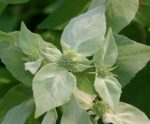 Also called short toothed mountain mint, this herbaceous perennial is in the dead nettle family, Lamiaceae, that also includes rosemary, ajuga, and monarda. It is native to Eastern North American from Maine to Michigan and Illinois, south to Florida and Texas, where it grows in woodlands, fields, meadows and grassy open spaces. Growing 1-3′ tall from a rhizomatous root system, the plant has branched stems with dark green leaves 1-3″ long. The oval leaves have pointed tips, heart shaped bases, toothed margins and a strong spearmint aroma when crushed. From mid to late summer 1/2-2″ wide terminal flat-topped clusters of two-lipped tubular pink appear appear. The flowers are up to 1/2″ wide and are attractive to bees, beneficial wasps, moths, and butterflies. Showy silvery leaf-like bracts subtend the flower clusters and add to the ornamental attractiveness of the plant. A good choice for butterfly, cottage, and wildflower gardens. The genus name, Pycnanthemum, comes from the Greek words pyknos meaning dense and anthos meaning flower and refers to the clusters of densely packed flowers. The specific epithet, muticum, is the Latin word meaning blunt and refers to the shape of the bracts at the top of each stem.
Also called short toothed mountain mint, this herbaceous perennial is in the dead nettle family, Lamiaceae, that also includes rosemary, ajuga, and monarda. It is native to Eastern North American from Maine to Michigan and Illinois, south to Florida and Texas, where it grows in woodlands, fields, meadows and grassy open spaces. Growing 1-3′ tall from a rhizomatous root system, the plant has branched stems with dark green leaves 1-3″ long. The oval leaves have pointed tips, heart shaped bases, toothed margins and a strong spearmint aroma when crushed. From mid to late summer 1/2-2″ wide terminal flat-topped clusters of two-lipped tubular pink appear appear. The flowers are up to 1/2″ wide and are attractive to bees, beneficial wasps, moths, and butterflies. Showy silvery leaf-like bracts subtend the flower clusters and add to the ornamental attractiveness of the plant. A good choice for butterfly, cottage, and wildflower gardens. The genus name, Pycnanthemum, comes from the Greek words pyknos meaning dense and anthos meaning flower and refers to the clusters of densely packed flowers. The specific epithet, muticum, is the Latin word meaning blunt and refers to the shape of the bracts at the top of each stem.
Type: Herbaceous perennial
Bloom: Clusters of tubular pink flowers from mid to late summer
Size: 1-3′ H x 1-3″ W
Light: Full sun to part shade
Soil: Fertile, moist to moderately moist, well-drained
Hardiness: Zones 4-8
Care: Prune or contain roots to prevent unwanted spread.
Pests and Diseases: Susceptible to rust
Propagation: Seed, division
Companion Plants: Liatris spiata, Coreopsis tripteris, Rudbeckia hirta